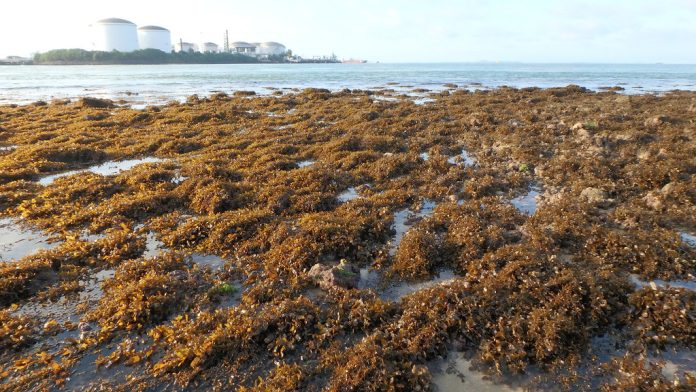
“It’s not a good sign.” That was the blunt view of researchers monitoring an occurrence now spanning close to 8,850 kilometers wide across the Atlantic Ocean. What had initially started out as isolated clumps of drift seaweed has turned into the Great Atlantic Sargassum Belt, a gigantic brown belt distinguishable from outer space, and it is transforming the ecological and economic dynamics of coastlines as a whole.
From a harmless Sargasso Sea drifter, sargassum has become a land-based invasive weed, strangling beaches, emitting foul odors, and paralyzing shore economy. Its uncontrolled spreading from 2011 has left scientists stunned, scrambling to know the reasons, nutrients fueled by pollution to changing ocean currents and determine how to stop its destruction.
This update includes the most urgent scientific data, health threats, and novel methods to fight the sargassum influx, based on recent peer-reviewed publications, field observations, and technological innovations.

1. A Record Bloom Never Previously Experienced
There was no Great Atlantic Sargassum Belt prior to 2011. Now it’s a virtual unbroken algal chain from West Africa to the Gulf of Mexico. In May of 2025, biomass levels soared to a record high of 37.5 million tons excluding the baseline of 7.3 million tons in the Sargasso Sea. Specialists report that it is not an isolated occurrence but rather an annual phenomenon with only 2013 having a counter. The rapidity and magnitude of its growth have scientists wondering, attributing the boom to climate change, altered currents, and land-based nutrient loading.

2. Nutrient Pollution: The Fertilizer Effect on the Open Ocean
Three decades of evidence now confirm that sargassum thrives where nutrients abound. Mississippi, Atchafalaya, and Amazon River runoff brings agricultural runoff and wastewater into the Atlantic, serving as a gargantuan fertilizer. Laboratory experiments confirm the observation that the most successful species, Sargassum natans and Sargassum fluitans, double biomass in only 11 days under enriched conditions. Nitrogen in sargassum tissue increased over 50% between 1980s and 2020s while phosphorus decreased slightly, increasing the nitrogen-to-phosphorus ratio a definitive indicator of high land-based nutrient input.

3. Health Hazard of Toxic Gas Release
When sargassum beach washes up on shore and spoils, it emits hydrogen sulfide (H₂S) and ammonia. H₂S, whose odor smells like rotten eggs, is extremely toxic at high concentration. Red alerts have been activated by air-quality monitors in Martinique and Guadeloupe, prompting the closure of schools and the evacuation of marinas. The University Hospital of Martineline conducted a recent study, which found elevated rates of hypertensive disorders, lower gestational ages, and lower infant weights in pregnant women who lived or worked within less than 2 km of strandings. Long-term exposure has also been associated with respiratory, dermatologic, and neurological symptoms.

4. Coastal Economies in Jeopardy
Worst hit are coastal areas from the Caribbean to West Africa. Beaches are invaded by tourists, and the sheer weight of the mats destroys coral reefs and seagrass beds. Expensive to clean up, the cost is a million dollars a year and puts city coffers under strain. A 1991 biomass bloom even led a Florida nuclear power plant to be closed after intake pipes were clogged. The University of South Florida’s new Coastal Vulnerability Index now takes into account sargassum effects, which deemed the Mexican Caribbean and Lesser Antilles to be among the most economically and ecologically vulnerable areas.

5. Ocean Eddies and the Hidden Highways of Seaweed

Apart from the big ocean currents, smaller ocean features are also dictating the path of the belt. Research in the Geophysical Research Letters indicates that cyclonic eddies vortex masses of seawater under neighboring oceans are 47% more prone to have sargassum than the surrounding oceans. Not only do they carry the algae, but they also nurture it by holding on to nutrients. Monitoring them by satellite altimetry may be one way of predicting where blooms will intensify, giving coastal managers a lead time of days to plan.

6. Converting a Pest into a Building Block
Brazilian engineers created lightweight ceramic aggregates by mixing up to 40% sargassum and clay and sintering in microwave kilns. They are strength compliant, enhance insulation, and possess a smaller environmental impact than traditional expanded clay. Life cycle assessment shows reduced material use and improved energy efficiency. Mexican entrepreneur Omar Vázquez Sánchez has led the way in Mexico’s state of Quintana Roo with 60% sargassum and 40% adobe and clay bricks hurricane-resistant, cost-effective, and already applied to constructing houses for poor households.

7. The Call for Basin-Wide Coordination of Action
Based on experts, the Great Atlantic Sargassum Belt is not a regional phenomenon but an alteration of the ecosystem in the basin. It will take land-sea management, nutrient runoff reductions, and global monitoring networks to reverse it. According to FAU Harbor Branch’s Brian Lapointe, “Understanding why sargassum is growing so much is crucial for managing these impacts.” Unchecked, the expansion of the belt might strain the ability of countries harmed to respond, multiplying environmental and economic destruction.

The Great Atlantic Sargassum Belt is an expression of linked change everywhere in the world ocean warming, changed ocean currents, and human-induced loading of nutrients. It is an experiment in resilience, pushing science, policy, and technology against one another in order to resist together. Whether the future is cleaner beaches or continued deteriorating year-by-year crisis is up to the pace and efficiency with which these lessons are heard.


